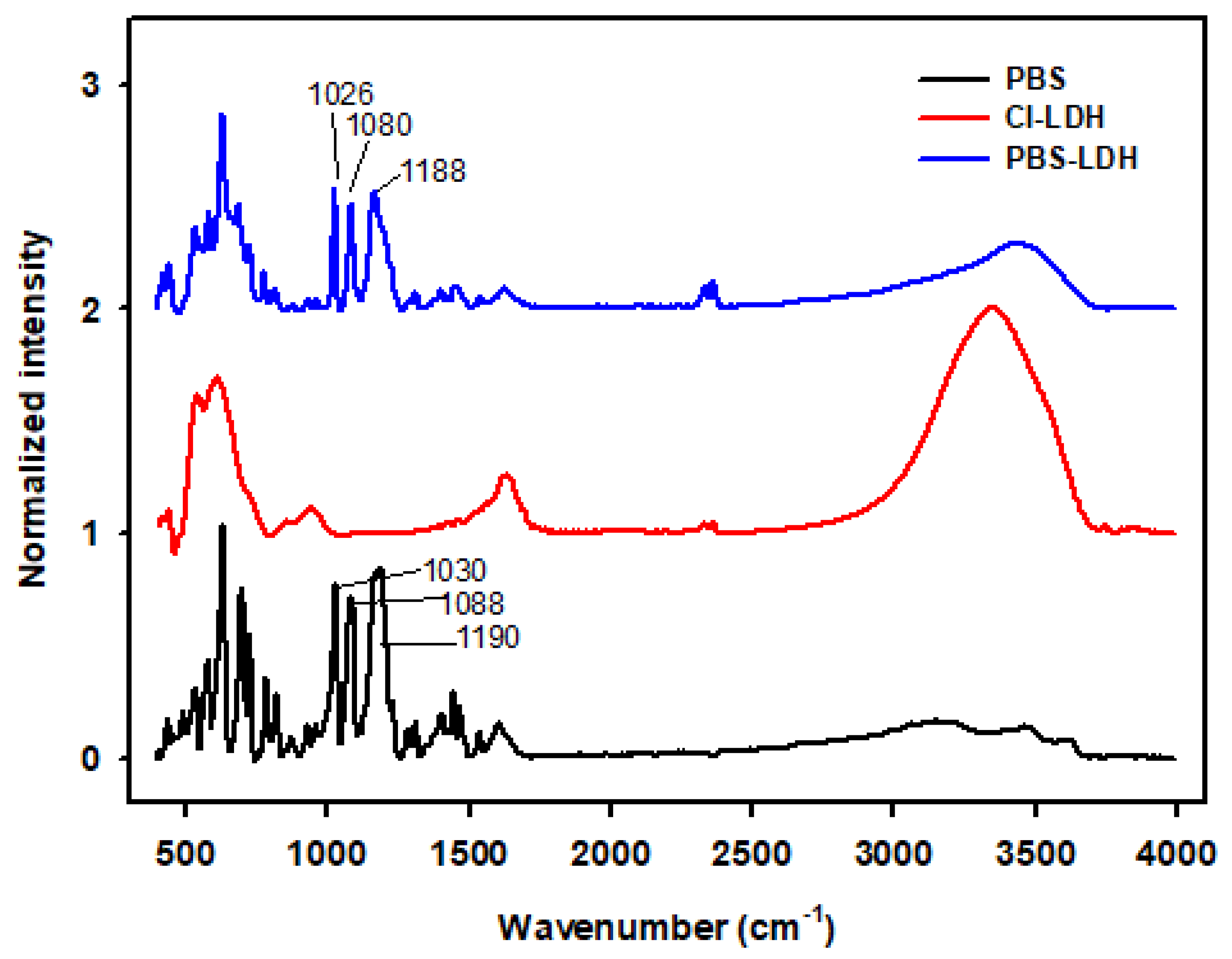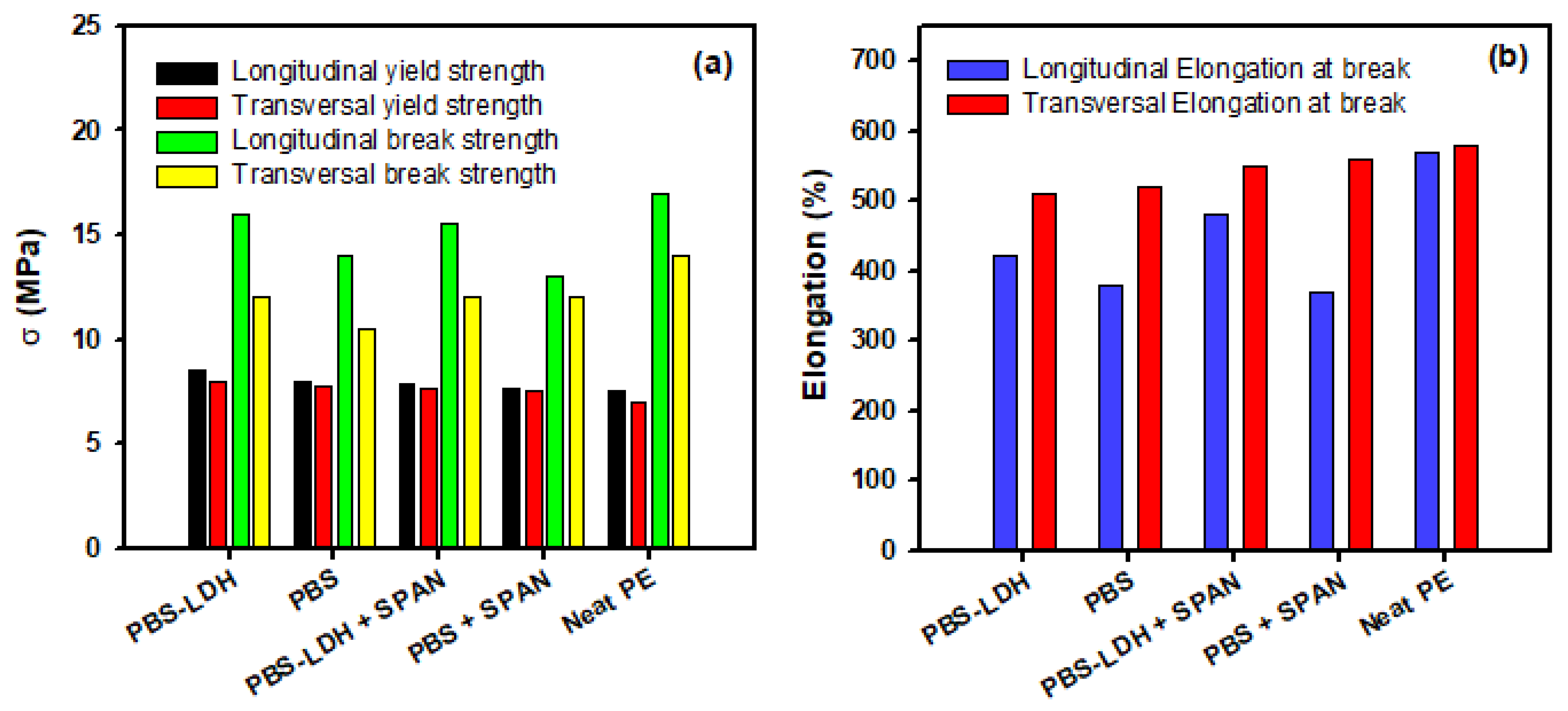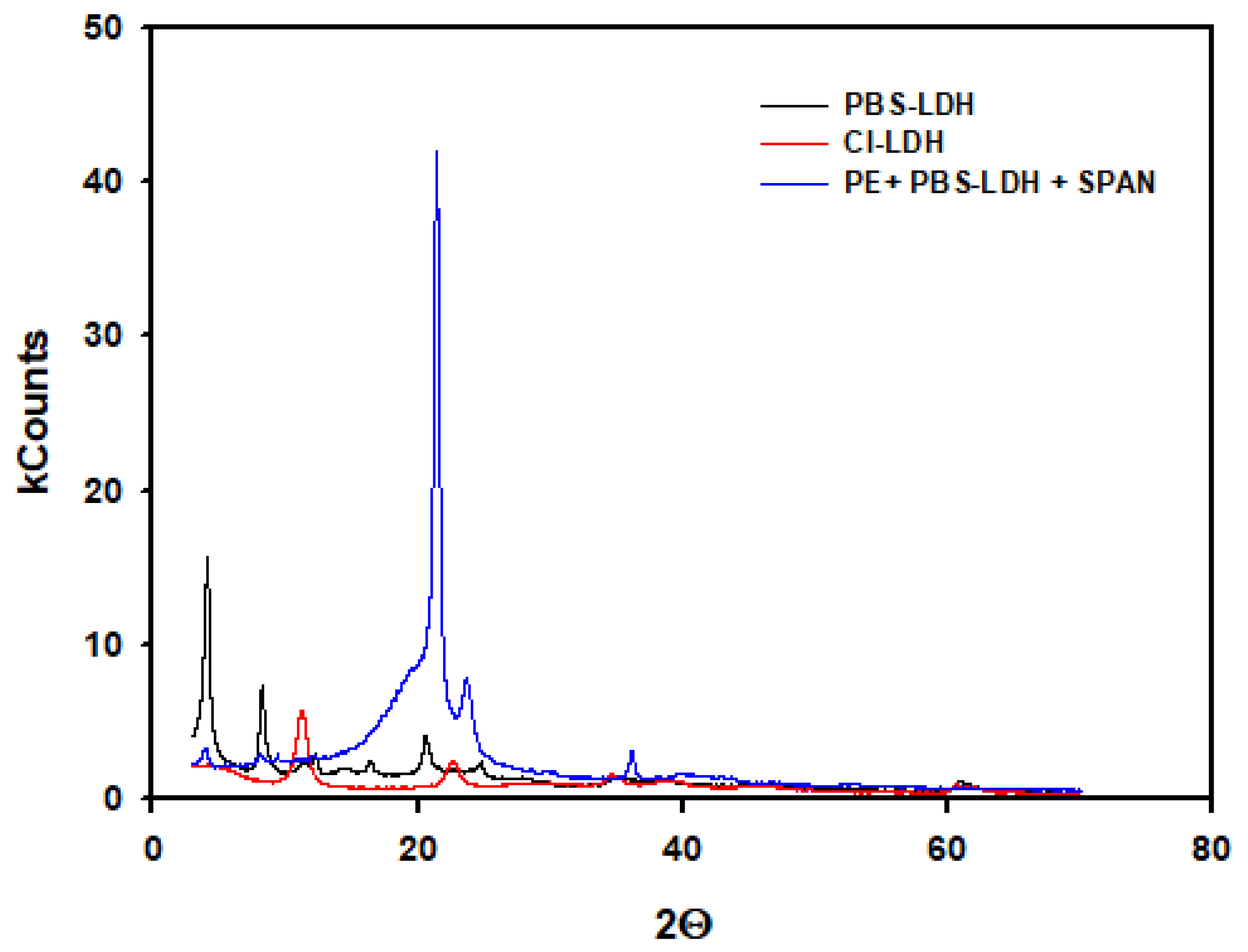Improvement of Age-Resistance of LDPE-Based Nanocomposite Films by Addition of a Modified Layered Double Hydroxide with an Anionic UV Screener
Abstract
:1. Introduction
2. Materials and Methods
3. Results
3.1. Encapsulation of the UV Absorber and Characterisation of the Modified LDH
3.1.1. Intercalation of PBS in LDH and Determination of the Composition of PBS-LDH
3.1.2. FT-IR Spectroscopy Characterization of the New PBS-LDH
3.1.3. Thermogravimetric Analysis of PBS-LDH
3.2. Characterization of the New Nanocomposites
3.2.1. Optical Properties and UV-Aging Effect of the New Composites
3.2.2. Mechanical and Rheological Properties and XRD Patterns of the New Films
4. Discussion
5. Conclusions
Author Contributions
Funding
Conflicts of Interest
References
- Leroux, F.; Besse, J. Polymer interleaved layered double hydroxide: A new emerging class of nanocomposites. Chem. Mater. 2001, 13, 3507–3515. [Google Scholar] [CrossRef]
- Bubniak, G.A.; Schreiner, W.H.; Mattoso, N.; Wypych, F. Preparation of a new nanocomposite of Al0.33Mg0.67(OH)2(C12H25SO4)0.33 and poly(ethylene oxide). Langmuir 2002, 18, 5967–5970. [Google Scholar] [CrossRef]
- Pereira, C.M.C.; Herrero, M.; Labajos, F.M.; Marques, A.T.; Rives, V. Preparation and properties of new flame retardant unsaturated polyester nanocomposites based on layered double hydroxides. Polym. Degrad. Stab. 2009, 94, 939–946. [Google Scholar] [CrossRef]
- Du, L.; Qu, B.; Zhang, M. Thermal properties and combustion characterization of nylon 6/MgAl-LDH nanocomposites via organic modification and melt intercalation. Polym. Degrad. Stab. 2007, 92, 497–502. [Google Scholar] [CrossRef]
- Mochane, M.J.; Magagula, S.I.; Sefadi, J.S.; Sadiku, E.R.; Mokhena, T.C. Morphology, Thermal Stability, and Flammability Properties of Polymer-Layered Double Hydroxide (LDH) Nanocomposites: A Review. Crystals 2020, 10, 612. [Google Scholar] [CrossRef]
- Pamies, R. Polymer Rheology and Processing of Nano- and Micro-Composites. Materials 2022, 15, 7297. [Google Scholar] [CrossRef]
- Cozzarini, L.; Benedetti, E.; Piras, A.; Terenzi, A.; Pricl, S.; Schmid, C. Mechanical and flammability properties of a polyamide 6,6 nanocomposite for nonstructural marine engine components. J. Polym. Eng. 2021, 41, 27–33. [Google Scholar] [CrossRef]
- Zhao, H.; Nagy, K.L. Dodecyl sulfate-hydrotalcite nanocomposites for trapping chlorinated organic pollutants in water. J. Colloid. Interface Sci. 2004, 274, 613–624. [Google Scholar] [CrossRef]
- Maziarz, P.; Matusik, J.; Leiviskä, T. Mg/Al LDH Enhances Sulfate removal and Clarification of AMD Wastewater in Precipitation Processes. Materials 2019, 12, 2334. [Google Scholar] [CrossRef]
- Lerner, D.A.; Bégu, S.; Aubert-Pouëssel, A.; Polexe, R.; Devoisselle, J.-M.; Azaïs, T.; Tichit, D. Synthesis and Properties of New Multilayer Chitosan@layered Double Hydroxide/Drug Loaded Phospholipid Bilayer Nanocomposite Bio-Hybrids. Materials 2020, 13, 3565. [Google Scholar] [CrossRef]
- Saha, C.; Ponnupandian, S.; Costa, F.R.; Heinrich, G.; Singha, N.K. Polydimethylsiloxane based polyurethane and its composite with layered double hydroxide: Synthesis and its thermal properties. Polym. Eng. Sci. 2021, 61, 3163–3169. [Google Scholar] [CrossRef]
- Jaerger, S.; Wypych, F. Thermal and flammability properties influenced by Zn/Al, Co/Al, and Ni/Al layered double hydroxide in low-density polyethylene nanocomposites. J. Appl. Polym. Sci. 2020, 137, 48737. [Google Scholar] [CrossRef]
- Machrouhi, A.; Taoufik, N.; Elhalil, A.; Tounsadi, H.; Rais, Z.; Barka, N. Patent Blue V Dye Adsorption by Fresh and Calcined Zn/Al LDH: Effect of Process Parameters and Experimental Design Optimization. J. Compos. Sci. 2022, 6, 115. [Google Scholar] [CrossRef]
- Tsai, T.Y.; Bunekar, N.; Wu, T.C. The Role of Organomodified Different LDHs on Recycled Poly(ethylene terephthalate) Nanocomposites. J. Chin. Chem. Soc. 2017, 64, 851–859. [Google Scholar] [CrossRef]
- Costa, F.R.; Wagenknecht, U.; Jehnichen, D.; Goad, M.A.; Heinrich, G. Nanocomposites based on polyethylene and Mg–Al layered double hydroxide. Part II. Rheological characterization. Polymer 2006, 47, 1649–1660. [Google Scholar] [CrossRef]
- Zahra, S.; Abbas, S.S.; Mahsa, M.-T.; Mohsen, N. Biodegradation of low-density polyethylene (LDPE) by isolated fungi in solid waste medium. Waste Manag. 2010, 30, 396–401. [Google Scholar] [CrossRef]
- Awasthi, S.; Srivastava, P.; Singh, P.; Tiwary, D.; Mishra, P.K. Biodegradation of thermally treated high-density polyethylene (HDPE) by Klebsiella pneumoniae CH001. 3 Biotech 2017, 7, 332. [Google Scholar] [CrossRef]
- Rajandas, H.; Parimannan, S.; Sathasivam, K.; Ravichandran, M.; Yin, L.S. A novel FTIR-ATR spectroscopy based technique for the estimation of low-density polyethylene biodegradation. Polym. Test. 2012, 31, 1094–1099. [Google Scholar] [CrossRef]
- Tsala-Mbala, C.; Hayibo, K.S.; Meyer, T.K.; Couao-Zotti, N.; Cairns, P.; Pearce, J.M. Technical and Economic Viability of Distributed Recycling of Low-Density Polyethylene Water Sachets into Waste Composite Pavement Blocks. J. Compos. Sci. 2022, 6, 289. [Google Scholar] [CrossRef]
- Dilara, P.A.; Briassoulis, D. Degradation and Stabilization of Low-density Polyethylene Films used as Greenhouse Covering Materials. J. Agric. Eng. Res. 2000, 76, 309–321. [Google Scholar] [CrossRef]
- Monzo, F.; Caparros, A.V.; Perez-Perez, D.; Arribas, A.; Pamies, R. Synthesis and Characterization of New Layered Double Hydroxide-Polyolefin Film Nanocomposites with Special Optical Properties. Materials 2019, 12, 3580. [Google Scholar] [CrossRef] [PubMed]
- Inbaraj, J.J.; Bilski, P.; Chignell, C.F. Photophysical and photochemical studies of 2-phenylbenzimidazole and UVB sunscreen 2-phenylbenzimidazole-5-sulfonic acid. Photochem. Photobiol. 2002, 75, 107–116. [Google Scholar] [CrossRef] [PubMed]
- Shen, L. Photophysical and photosensitizing characters of 2-phenylbenzimidazole-5-sulfonic acid. A theoretical study. Spectrochim. Acta Part A Mol. Biomol. Spectrosc. 2015, 150, 187–189. [Google Scholar] [CrossRef]
- Perioli, L.; Ambrogi, V.; Rossi, C.; Latterini, L.; Nocchetti, M.; Costantino, U. Use of anionic clays for photoprotection and sunscreen photostability: Hydrotalcites and phenylbenzimidazole sulfonic acid. J. Phys. Chem. Solids 2006, 67, 1079–1083. [Google Scholar] [CrossRef]
- Iyi, N.; Matsumoto, T.; Kaneko, Y.; Kitamura, K. Deintercalation of carbonate ions from a hydrotalcite-like compound: Enhanced decarbonation using acid-salt mixed solution. Chem. Mater. 2004, 16, 2926–2932. [Google Scholar] [CrossRef]
- Saravanabharathi, D.; Obulichetty, M.; Kumaravel, M. Facile crystallization of 2-phenyl benzimidazole-5-sulfonic acid: Characterization of lattice water dependent zwitterionic supramolecular forms, with modulation in proton conductivities. J. Chem. Sci. 2019, 131, 72. [Google Scholar] [CrossRef]
- Shishlov, N.M.; Khursan, S.L. Effect of ion interactions on the IR spectrum of benzenesulfonate ion. Restoration of sulfonate ion symmetry in sodium benzenesulfonate dimer. J. Mol. Struct. 2016, 1123, 360–366. [Google Scholar] [CrossRef]
- Langner, R.; Zundel, G. FTIR investigation of O center dot center dot center dot H center dot center dot center dot O hydrogen bonds with large proton polarizability in sulfonic acid-N-oxide systems in the middle and far-IR. J. Chem. Soc. Faraday Trans. 1998, 94, 1805–1811. [Google Scholar] [CrossRef]
- Perpetuo, G.J.; Goncalves, R.S.; Janczak, J. Supramolecular hydrogen-bonding network in 1-(diaminomethylene)thiouron-1-ium 4-hydroxybenzenesulfonate crystal. J. Mol. Struct. 2015, 1096, 74–83. [Google Scholar] [CrossRef]
- Kaczmarek, H.; Oldak, D.; Podgorski, A. Photochemical properties of polyethylene modified by low-molecular organic compounds. Polym. J. 2003, 35, 634–639. [Google Scholar] [CrossRef]
- Georgantopoulos, C.K.; Esfahani, M.K.; Naue, I.F.C.; Wilhelm, M.; Kadar, R. Role of molecular architecture and temperature on extrusion melt flow instabilities of two industrial LLDPE and LDPE polyethylenes investigated by capillary rheology, high-pressure sensitivity slit die and optical analysis. J. Appl. Polym. Sci. 2022, 40, e53165. [Google Scholar] [CrossRef]
- Solera, P. New trends in polymer stabilization. J. Vinyl Addit. Technol. 1998, 4, 197–210. [Google Scholar] [CrossRef]
- Stevenson, C.; Davies, R.J.H. Photosensitization of guanine-specific DNA damage by 2- phenylbenzimidazole and the sunscreen agent 2-phenylbenzimidazole-5-sulfonic acid. Chem. Res. Toxicol. 1999, 12, 38–45. [Google Scholar] [CrossRef] [PubMed]
- Battacharjee, L.; Jazaei, F.; Salehi, M. Insights into the mechanism of plastics’ fragmentation under abrasive mechanical forces: An implication for agricultural soil health. Clean Soil Air Water 2023, 51, 2200395. [Google Scholar] [CrossRef]
- Lim, J.; Kim, S.J. Fabrication and experimental evaluation of a polymer-based flexible pulsating heat pipe. Energy Convers. Manag. 2018, 156, 358–364. [Google Scholar] [CrossRef]
- Hong, Z.; Chen, X.; Zhu, H.; Zhang, T.; Li, H.; Awais, M.; Paramane, A. Insulation properties enhancement of crosslinked polyethylene by grafting electron-buffering voltage stabilizers. J. Appl. Polym. Sci. 2023, E54633. [Google Scholar] [CrossRef]
- Lonkar, S.P.; Therias, S.; Caperaa, N.; Leroux, F.; Gardette, J.L. Photooxidation of polypropylene/layered double hydroxide nanocomposites: Influence of intralamellar cations. Eur. Polym. J. 2010, 46, 1456–1464. [Google Scholar] [CrossRef]
- Bastien, N.; Millau, J.-F.; Rouabhia, M.; Davies, R.J.H.; Drouin, R. The sunscreen agent 2-phenylbenzimidazole-5-sulfonic acid photosensitizes the formation of oxidized guanines in cellulo after UV-A or UV-B exposure. J. Investig. Dermatol. 2010, 130, 2463–2471. [Google Scholar] [CrossRef]
- Saritha, A.; Joseph, K. Melt Rheological Properties of Layered Double Hydroxide Polymer Nanocomposites; Woodhead Publishing: Sawston, UK, 2020. [Google Scholar] [CrossRef]
- Lee, W.D.; Im, S.S.; Lim, H.M.; Kim, K.J. Preparation and properties of layered double hydroxide/poly(ethylene terephthalate) nanocomposites by direct melt compounding. Polymer 2006, 47, 1364–1371. [Google Scholar] [CrossRef]
- Wang, L.J.; Su, S.P.; Chen, D.; Wilkie, C.A. Variation of anions in layered double hydroxides: Effects on dispersion and fire properties. Polym. Degrad. Stab. 2009, 94, 770–781. [Google Scholar] [CrossRef]







| L/D Ratio | Diameter | Die Width | Calender Width | Speed | Die Pressure |
|---|---|---|---|---|---|
| 25 mm | 20 mm | 100 mm | 220 mm | 60 rpm | 45 bares |
| Temperature ramp | |||||
| Feeding | Zone 1 | Zone 2 | Zone 3 | Zone 4 | Die |
| 35 °C | 200 °C | 208 °C | 209 °C | 185 °C | 190 °C |
| Concentration (wt. %) | ||
|---|---|---|
| Elements | Cl-LDH | PBS-LDH |
| Na | 2.03 | 0.775 |
| Mg | 13.55 | 6.89 |
| Al | 14.63 | 5.88 |
| S | 0.058 | 5.51 |
| C | 0.34 | 27.64 |
| Cl | 14.73 | 1.08 |
| H | 3.70 | 5.42 |
| N | - | 4.95 |
| Concentration (wt. %) | ||||
|---|---|---|---|---|
| Sample | LDPE | PBS-LDH | PBS | SPAN |
| 1 | 99 | 1 | 0 | 0 |
| 2 | 99 | 0 | 1 | 0 |
| 3 | 98 | 1 | 0 | 1 |
| 4 | 98 | 0 | 1 | 1 |
| 5 | 100 | 0 | 0 | 0 |
Disclaimer/Publisher’s Note: The statements, opinions and data contained in all publications are solely those of the individual author(s) and contributor(s) and not of MDPI and/or the editor(s). MDPI and/or the editor(s) disclaim responsibility for any injury to people or property resulting from any ideas, methods, instructions or products referred to in the content. |
© 2023 by the authors. Licensee MDPI, Basel, Switzerland. This article is an open access article distributed under the terms and conditions of the Creative Commons Attribution (CC BY) license (https://creativecommons.org/licenses/by/4.0/).
Share and Cite
Monzó, F.; Arribas, A.; Carrión-Vilches, F.J.; Pamies, R. Improvement of Age-Resistance of LDPE-Based Nanocomposite Films by Addition of a Modified Layered Double Hydroxide with an Anionic UV Screener. J. Compos. Sci. 2023, 7, 388. https://doi.org/10.3390/jcs7090388
Monzó F, Arribas A, Carrión-Vilches FJ, Pamies R. Improvement of Age-Resistance of LDPE-Based Nanocomposite Films by Addition of a Modified Layered Double Hydroxide with an Anionic UV Screener. Journal of Composites Science. 2023; 7(9):388. https://doi.org/10.3390/jcs7090388
Chicago/Turabian StyleMonzó, Fuensanta, Alejandro Arribas, Francisco José Carrión-Vilches, and Ramón Pamies. 2023. "Improvement of Age-Resistance of LDPE-Based Nanocomposite Films by Addition of a Modified Layered Double Hydroxide with an Anionic UV Screener" Journal of Composites Science 7, no. 9: 388. https://doi.org/10.3390/jcs7090388
APA StyleMonzó, F., Arribas, A., Carrión-Vilches, F. J., & Pamies, R. (2023). Improvement of Age-Resistance of LDPE-Based Nanocomposite Films by Addition of a Modified Layered Double Hydroxide with an Anionic UV Screener. Journal of Composites Science, 7(9), 388. https://doi.org/10.3390/jcs7090388







